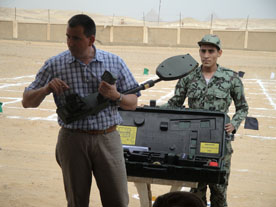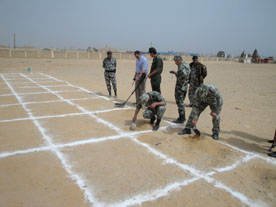Egyptian desert: new technologies for landmine detection
Egypt is regarded as one of the most contaminated countries in the world in terms of the number of mines and explosive remnants of war scattered across its territory. The issue poses a serious security challenge for local populations and hinders economic development and investment. As a result, large swathes of land are rendered unsafe and unusable.

In a coordinated effort to tackle this issue, NATO and Egypt recently completed a two-year project to introduce advanced detection systems suitable for demining in the Egyptian desert.
The challenges
The majority of landmines in Egypt are remnants of military action during World War II. As these devices date back several decades, mapping and detection can be extremely difficult. “One major factor that makes landmine detection in Egypt extremely complex is the terrain and the fact that over the years moving sands have buried many of them at great depths, rendering conventional detection methods ineffective,” says Dr Eyup Turmus, NATO Science Advisor.
Today, it is thought that at least ten per cent of landmines and explosive remnants across Egypt are at depths of over 1.5 metres. Another major problem is that these devices are often found in locations contaminated with metal fragments from former battlefields. The challenge is that widely-used manually operated metal detectors cannot discriminate between mines and harmless metal fragments, leading to false alarms. As each alarm signal must be investigated by the Egyptian authorities, this slows down demining operations considerably.
Developing intelligent detectors

Launched in 2012, this project aims to help Egyptian deminers to develop an operational capability for both dual-sensor and deep-search detectors.
The first phase of the project sought to develop dual-sensor technologies with a ground-penetrating radar (GPR), making it possible to not only detect metallic objects but also to deduce volume, allowing metal fragments to be distinguished from mines. GPR technology also facilitates mine-detection operations by enabling the mapping of the sub-surface, as it can detect objects, volumes and areas that have different electromagnetic properties.
As dual-sensor detectors are only able to detect mines and explosive remnants to a depth of between 0.5 and 1 metre, specific deep-search detectors were employed during the second phase of the project. Now that the project is completed the group of Egyptian Military Engineers will benefit from the advanced detection equipment, which will result in better, safer and faster demining of the mine-affected areas in Egypt.
Exploring new avenues of collaboration

“Egypt faces a profound challenge from the over 20 million landmines scattered around the country. This collaborative project addresses a major security issue, but also has an important humanitarian component promoting NATO’s image in Egypt and the region,” said the late Brigadier General Maged Ahmed Saleh, formerly Chief of Engineering at the Military Engineers Department of the Ministry of Defence, killed in action shortly after the interview.
Following the successful completion of this project, discussions are underway for a potential follow-up that would include detection of unexploded ordnance (UXO).
“This project represents one of the flagship activities of cooperation between NATO and Egypt, constituting a strong basis for new avenues of collaboration in the future,” says Assistant Secretary General of NATO’s Emerging Security Challenges Division, Ambassador Sorin Ducaru.
The project was developed through the NATO Science for Peace and Security (SPS) Programme, a partnership tool of the Emerging Security Challenges Division.
